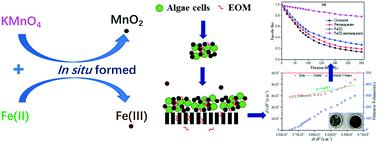当前位置:
X-MOL 学术
›
Environ. Sci.: Water Res. Technol.
›
论文详情
Our official English website, www.x-mol.net, welcomes your feedback! (Note: you will need to create a separate account there.)
Algae-laden water treatment with ultrafiltration: effects of moderate oxidation by Fe(II)/permanganate on hydraulically irreversible fouling and deposition of iron and manganese oxides
Environmental Science: Water Research & Technology ( IF 5 ) Pub Date : 2020-10-23 , DOI: 10.1039/d0ew00833h Fangshu Qu 1, 2, 3, 4, 5 , Zhimeng Yang 1, 2, 3, 4 , Huarong Yu 1, 2, 3, 4, 5 , Hong Zhou 1, 2, 3, 4 , Gongduan Fan 5, 6, 7, 8 , Junguo He 1, 2, 3, 4, 5 , Hongwei Rong 1, 2, 3, 4, 5
Environmental Science: Water Research & Technology ( IF 5 ) Pub Date : 2020-10-23 , DOI: 10.1039/d0ew00833h Fangshu Qu 1, 2, 3, 4, 5 , Zhimeng Yang 1, 2, 3, 4 , Huarong Yu 1, 2, 3, 4, 5 , Hong Zhou 1, 2, 3, 4 , Gongduan Fan 5, 6, 7, 8 , Junguo He 1, 2, 3, 4, 5 , Hongwei Rong 1, 2, 3, 4, 5
Affiliation

|
Application of ultrafiltration (UF) in algae-laden water treatment is hindered by severe fouling and low retention of soluble organics. In this study, moderate oxidation by Fe(II)/permanganate was investigated as a pretreatment for algae-laden water before UF in comparison with permanganate oxidation alone and Fe(II) coagulation alone. Filtration tests were performed to assess the impacts of moderate oxidation on fouling reversibility, fouling mechanisms and compositions of the fouling layers. The results showed that Fe(II)/permanganate substantially alleviated the flux reduction by 65% and reduced reversible resistances by nearly 2 orders of magnitude, because the agglomerates formed by foulants and in situ formed iron and manganese oxides were larger in size than the algal cells, resulting in more porous fouling layers. The fouling mechanism shifted from the dual mechanism of successive pore blocking and cake filtration to single standard blocking over the whole duration investigated. However, irreversible fouling was aggravated by Fe(II)/permanganate, because the cake filtration was weakened and the adhesion of EOM on the membrane was aggravated in the presence of in situ formed iron and manganese oxides. The iron and manganese oxides deposited in the external fouling layer rather than inside the membrane. The amounts of Fe and Mn in the fouling layer substantially increased by more than 4 times with Fe(II)/permanganate than with permanganate or Fe(II). Fe(II)/permanganate increased the removal of EOM (67%) by UF, attributing the enhanced adsorption of EOM to both the membrane and the agglomerates.
中文翻译:

藻类水超滤处理:Fe(II)/高锰酸盐的适度氧化对水力不可逆结垢和铁和锰氧化物沉积的影响
超滤(UF)在含藻类水处理中的应用由于严重的结垢和可溶性有机物的低保留而受到阻碍。在这项研究中,与单独的高锰酸盐氧化和单独的Fe(II)凝结相比,研究了Fe(II)/高锰酸盐的适度氧化作为超滤前藻类水的预处理。进行过滤测试以评估适度氧化对结垢可逆性,结垢机理和结垢层组成的影响。结果表明,Fe(II)/高锰酸盐可将通量降低幅度降低65%,并将可逆电阻降低近2个数量级,这是因为由结垢和原位形成的附聚物形成的铁和锰的氧化物的尺寸大于藻细胞,导致形成更多的多孔污垢层。在整个研究过程中,结垢机理从连续的孔堵塞和滤饼过滤的双重机理转变为单一标准的堵塞。然而,由于在原位形成的铁和锰的氧化物的存在下滤饼的过滤作用减弱并且EOM在膜上的粘附力增加,因此Fe(II)/高锰酸盐加剧了不可逆的结垢。铁和锰的氧化物沉积在外部污垢层中,而不是在膜内部。Fe(II)/高锰酸盐的结垢层中的Fe和Mn含量比高锰酸盐或Fe(II)。Fe(II)/高锰酸盐增加了UF对EOM的去除率(67%),这归因于EOM对膜和附聚物的吸附增强。
更新日期:2020-12-17
中文翻译:

藻类水超滤处理:Fe(II)/高锰酸盐的适度氧化对水力不可逆结垢和铁和锰氧化物沉积的影响
超滤(UF)在含藻类水处理中的应用由于严重的结垢和可溶性有机物的低保留而受到阻碍。在这项研究中,与单独的高锰酸盐氧化和单独的Fe(II)凝结相比,研究了Fe(II)/高锰酸盐的适度氧化作为超滤前藻类水的预处理。进行过滤测试以评估适度氧化对结垢可逆性,结垢机理和结垢层组成的影响。结果表明,Fe(II)/高锰酸盐可将通量降低幅度降低65%,并将可逆电阻降低近2个数量级,这是因为由结垢和原位形成的附聚物形成的铁和锰的氧化物的尺寸大于藻细胞,导致形成更多的多孔污垢层。在整个研究过程中,结垢机理从连续的孔堵塞和滤饼过滤的双重机理转变为单一标准的堵塞。然而,由于在原位形成的铁和锰的氧化物的存在下滤饼的过滤作用减弱并且EOM在膜上的粘附力增加,因此Fe(II)/高锰酸盐加剧了不可逆的结垢。铁和锰的氧化物沉积在外部污垢层中,而不是在膜内部。Fe(II)/高锰酸盐的结垢层中的Fe和Mn含量比高锰酸盐或Fe(II)。Fe(II)/高锰酸盐增加了UF对EOM的去除率(67%),这归因于EOM对膜和附聚物的吸附增强。


























 京公网安备 11010802027423号
京公网安备 11010802027423号